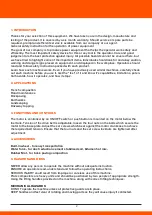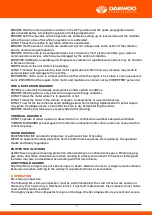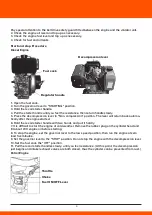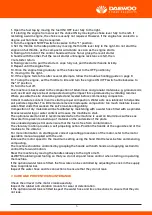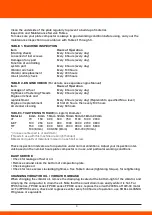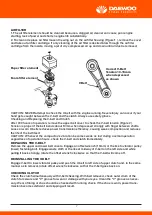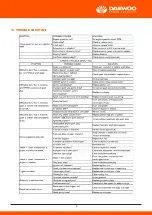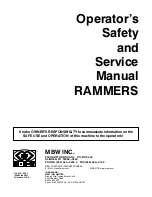
8
1. INTRODUCTION
Thanks for your selection of this equipment. We have taken care in the design, manufacture and
testing of the product. lt is covered by a six month warranty. Should service or spare parts be
required, prompt and efficient service is available from our company or our agent.
General safety instruction for the operation of power equipment
The goal of our company is to produce power equipment that helps the operator work safely and
efficiently. The most important safety device for this or any tool is the operator. Care and good
judgement are the best protection against injury. Ali possible hazards cannot be covered here, but
we have tried to highlight sorne of the important items, individuals should look for and abey caution,
warning and danger signs placed on equipment, and displayed in the workplace. Operators should
read and follow safety instruction packed with each product.
Learn how each machine works. Even if you have previously used similar machines, carefully check
out each machine befare you use it. Get the "feel" of it and know it's capabilities, limitations, poten-
tial hazards, how it operates, and how it stops.
2. APPLICATIONS
Trench compaction
Road maintenance
Brickpaving
Earthworks
Landscaping
Driveway topping
3. FUNCTIONS AND CONTROLS
The motor is controlled by an ON/OFF switch or push button is mounted on the motor below the
fuel tank. Tension of the drive belt is adjustable, loasen the tour nuts on the bolts which secure the
motor to the base plate. Adjust the set screws which bear against the motor crankcase to achieve
the required belt tension. Ensure that the tour nuts and the set screw locknuts are tightened after
adjustment.
4. ACCESSORIES
Built-in wheel - for easy transportation
Water tank - for dust reduction cement
stabilised soil, bitumen hot mix.
Rubber Mat - for brick paving compaction
5. HAZARDS AND RISKS
NEVER allow any person to operate the machine without adequate instruction.
ENSURE ali operators read, understand and follow the operating instructions.
SERIOUS INJURY could result from improper or careless use of this machine.
Plate compactors are heavy units and should be positioned by two people of appropriate strength.
Using the lifting handles provided on the machine, along with correct lifting techniques.
MECHANICAL HAZARDS
DO NOT operate the machine unless all protective guards are in place.
KEEP handles and feet clear of rotating and moving parts as they will cause injury if contacted.
ENSURE that the motor operation switch is in the OFF position and the spark plug ignition lead is
disconnected befare removing the guards or making adjustments.
ENSURE both the machine and the operator are stable by setting up on level terrain and the machine
will not tip over, slide of fall while in operation or unattended.
DO NOT leave the machine in operation while it is unattended.
ENSURE that the walls of a trench are stable and will not collapse due to the action of the vibration,
prior to commencing compaction.
ENSURE that the area to be compacted does not contain any "live" electrical cables, gas, water or
communication services which may be damaged by the action of vibration.
EXERCISE CARE when operating unit. Exposure to vibration or repetitive work actions may be harmful
to hands and arms.
NEVER stand on the unit while it is operating.
DO NOT increase the governed no-load motor speed above 3,500 r/min. Any increase may result in
personal injury and damage to the machine.
BE CAREFUL not to come in contact with the muffler when the engine is hot, since it can cause severe
burns. ENSURE that the repairs to the motor and machine are carried out by COMPETENT personnel.
FIRE & EXPLOSION HAZARDS
PETROL is extremely flammable and explosive under certain conditions.
ENSURE that the petral is only stored in an approved storage container.
DO NOT refuel the motor while it is in operation or hot.
DO NOT refuel the motor in the vicinity of sparks, a naked flame or a person smoking.
DO NOT over fill the fuel tank and avoid spilling petral when refueling. Spilled petral or petral vapour
may ignite. lf spillage occurs, ensure that the area is dry befare starting the motor.
ENSURE that the fuel tank cap is securely fitted after refueling.
CHEMICAL HAZARDS
DO NOT operate or refuel a petral or diesel motor in a confined area without adequate ventilation.
CARBON MONOXIDE exhaust gases from interna! combustion motor driven units can cause death in
confined spaces.
NOISE HAZARDS
EXCESSIVE NOISE can lead to temporary or permanent loss of hearing.
WEAR an approved hearing protection device to limit noise exposure. As required by Occupational
Health and Safety regulations.
PROTECTIVE CLOTHING
ALWAYS wear approved hearing protection when working in a confined work space. Protective gog-
gles and a dust mask should be worn when working in a dusty environment. Protective clothing and
footwear may also be desirable when working with hot mix bitumen.
ADDITIONAL HAZARDS
Slip/Trip/Fall is a major cause of serious injury or death. Beware of uneven or slippery work surfaces.
Exercise care when working in the vicinity of unprotected holes or excavations.
6. OPERATION
Pre-start-up inspection
The following Pre-start-up inspection must be performed before the start of each work session or
after every four hours of use, whichever is first.. lf any fault is discovered, the compactor must not be
used until the fault is rectified.
Thoroughly inspect the compactor for signs of damage. Check components are present and secure.
Pay special attention to the belt drive safety guard fitted between the engine and the vibrator unit.
2. Check the engine oil level and top up as necessary.
3. Check the engine fuel level and top up as necessary.
4. Check for fuel and oil leaks
Start and stop Procedure
Diesel Engine
1. Open the fuel cock.
2. Turn the governor lever to "STARTING" position.
3. Hold the recoil starter handle.
4. Pull the starter handle until you feel the resistance, then return handle slowly.
5. Press the decompression lever to "Non-compression" position. The lever will return back automa-
tically after the engine started.
6. Hold the recoil starter handle with two hands and pull it hardly.
7. lt is difficult to start the engine at cold weather. Remove the rubber plug on the cylinder head and
fill about 2CC engine oil before starting.
8. To stop the engine, set the governor lever to the low speed position, then run the engine at zero
load five minutes.
9. Set the governor lever to the "STOP" position. Do not stop the engine with the decompression lever.
10. Set the fuel cock the "OFF" position.
11. Pull the recoil starter handles slowly, until you feel resistance. (At this point, the decompression
just begins and intake/exhaust valves are both closed, thus the cylinder can be prevented from rust.)
Petrol Engine
1. Open the fuel tap by moving the fuel ON/OFF lever fully to the right.
2. lf starting the engine from cold, set the choke ON by moving the choke lever fully to the left. lf
restarting a warm engine, the choke is usually not required. However, if the engine has cooled to a
degree, partial choke may be required.
3. Turn the engine ON/OFF switch clockwise to the "1" position.
4. Set the throttle to the idle position by moving the throttle lever fully to the right. Do not start the
engine on full throttle, as the compactor will vibrate as soon as the engine starts.
5. Taking a firm hold of the control handle with one hand, grasp the recoil starter
6. handle with the other. Pull the recoil starter until engine resistance is felt, then
7. let starter return.
8. Taking care not to pull the starter's cope fully out, pull the starter handle briskly.
9. Repeat until the engine fires.
10. Once the engine fires gradually, set the choke lever to the OFF position by
11. moving it to the right.
12. lf the engine fails to fire after several attempts, follow the trouble-shooting guide on page 9.
13. To stop the engine, set the throttle to idle and turn the engine ON /OFF switch anticlockwise to
the "O" position.
14. Turn the fuel off.
The machine is best suited to the compaction of bituminous and granular materials e.g. granular soils
such as silt and clay are best compacted using the impact force produced by a vibrating rammer.
Where possible the site should be graded and leveled before commencing compaction.
Correct moisture content in soil is vital to proper compaction. Water acts as a lubricant to help slide
soil particles together. Too little moisture means inadequate compaction; too much moisture leaves
water-filled voids that weaken the soil's load-bearing ability.
Compaction of dry materials will be facilitated by moistening with a water hose fitted with a sprinkler.
Excessive watering or water content will cause the machine to stall.
The optional water tank kit is recommended when the machine is used on bituminous surfaces as
the water film prevents a build up of material on the underside of the plate.
Use unleaded grade petrol and ensure that the fuel is free from contamination.
The vibratory motion provides a self propelling action. Position the handle at the opposite end of the
machine to the vibrator.
For more information on starting and correct operating procedures of the motor, refer to the motor
operation manual supplied with the unit.
lncrease the motor speed to the maximum setting using the hand throttle lever, before commencing
compacting.
The machine should be controlled by grasping the handle with both hands and applying restraint to
control the forward motion.
Steer the machine by moving the handle sideways to the right or left.
ALWAYS maintain good footing so that you do not slip and loose control when starting or operating
the machine.
lf the optional water tank is fitted, the flow rate can be controlled by adjusting the cock in the supply
hose to sprinkler bar.
lnspect the water hose and its connections to ensure that they do not leak.
7. CARE AND PREVENTIVE MAINTENANCE
Check the oil level in the motor crankcase daily.
lnspect the rubber anti vibration mounts for wear or deterioration.
lf the optional water tank is fitted inspect the water hose and its connections to ensure that they do
not leak.
Clean the underside of the plate regularly to prevent a build up of material.
lnspection and Maintenance Service Tables.
To make sure your plate compactar is always in good working condition befare using, carry out the
maintenance inspection in accordance with Tables 1 through 3.
TABLE 1. MACHINE INSPECTION
ltem
Hours
of
Operation
(Starting check)
Every 8 hours (every day)
Loosened of lost screws
Every 8 hours (every day)
Damage of any part
Every 8 hours (every day)
Function of controlling
system part
Every 8 hours (every day)
Vibrator oil check
Every 100 hours
Vibrator oil replacement
Every 200 hours
V-belt (clutch) check
Every 200 hours
TABLE 2. ENGINE CHECK
(For details, see separate engine Manual)
ltem
Hours
of
Operation
Leakage of oil fuel
Every 8 hours (every day)
Tightness of fastening Threads
Every 8 hours (every day)
Engine oil check and
replenishment
Every 8 hours (every day) (Replenish to specified Max. level)
Engine oil replenishment
At first 20 hours, then every 100 hours
Air cleaner cleaning
Every 50 hours
TABLE 3. TIGHTENING TORQUE
(in. kg/cm) Diameter
Material
6mm 8mm 10mm 12mm 14mm 16mm 18mm 20mm
4T
70 150 300 500 750 1100 1400 2000
6-8T
100 250 500 800 1300 2000 2700 3800
11T
150 400 800 1200 2000 2900 4200 5600
*
100 (6mm)
300-350 (8mm)
650-700 (10mm)
* (in case counter-part is of aluminium)
(Threads in use with this machine are all right handed)
Material and quality of material is marked on each bolt screw.
These inspection intervals are for operation under normal conditions. Adjust your inspection inter-
vals based on the number hours plate compactar is in use, and particular working conditions.
DAILY SERVICE
• Check for leakage of fuel or oil.
• Remove soil and clean the bottom of compaction plate.
• Check engine oil.
• Check for loose screws including tightness. See Table 3 above (tightening torque), for retightening.
CHANGING VIBRATOR OIL / VIBRATOR GREASE
When changing the vibrator oil, remove the drain plug located at the bottom-right of the vibrator, and
simply tip the compactar to drain the oil. Note that the oil will drain more easily while it is hot. Far
FPC50 series, FPC60 series,FPC80 series,FPC90 series, replace the oil with 200ML of 10W-30 motor
oil; ForFPC100 series, check and regrease exciter every 500 hours of operation, use SHELL ALVANIA
R3 grease or equivalent.
AIR FILTER
1. The air filter element should be cleaned because a clogged air cleaner can cause poor engine
starting, lack of power and shorten engine life substantially.
2. To clean or replace air filter loasen the wing nut on the air filter housing (Figure 1 ), remove the cover
and take out air filter cartridge. lf only cleaning of the air filter is desired blow through the air filter
cartridge from the inside, moving a jet of dry compressed air up and down until all dust is removed.
CAUTION: NEVER attempt to check the V-belt with the engine running. Severe injury can occur if your
hand gets caught between the V-belt and the clutch. Always use safety gloves.
Checking and Replacing the V-belt and Clutch
After 200 hours of operation, remove the upper belt cover to check the V-belt tension (Figure 2).
Tension is proper if the belt bends about 10mm when depressed strongly with finger between shafts.
Loase or worn V-belts reduces power transmission efficiency, causing weak compaction and reduces
the life of the belt itself.
CAUTION: Whenever the compactoc's v;brat;on becomes weak oc los! dudng oocmal operation
cegacdless of operation hours, check the V-belt and clutch immediately.
REPLACING THE V-BELT
Remove the upper and lower belt covers. Engage an offset wrench (13mm) or the like to vibrator pulley
(lower) fastening bolt. Engage waste cloth or the like at midway of V-belt on the left side and while
pulling it back strongly, rotate the offset wrench clockwise so that the V-belt will come off.
REINSTALLING THE V-BELT
Engage V-belt to lower vibrator pulley and push the V-belt to left side of upper clutch and, in the same
manner as in removal, rotate offset wrench clockwise so that the V-belt goes back on.
CHECKING CLUTCH
Check the clutch simultaneously with V-belt checking. With belt removed, check outer drum of the
clutch far seizure and "V" groove far wear or damage with your eyes. Clean the "V" groove as neces-
sary. Wear of lining or shoe should be checked with running check. lf the shoe is worn, power trans-
mission becomes deficient and slipping will result.
8. SPECIFICATIONS
DATM60
Fuel
..................................................................
Gasoline
Power
..............................................................
6.5 Hp
Vibration Frequency
................................
5600vpm
Max. centrifugal force
............................
10.5 kN
Plate size
......................................................
50x36
Forward speed
..........................................
40cm/s
Compaction depth
..................................
20cm
Compacted area
......................................
450m² / hr
Gradeability
................................................
30%
DATM80
Fuel
..................................................................
Gasoline
Power
..............................................................
6.5 Hp
Vibration Frequency
................................
5500 vpm
Max. Centrifugal Force
..........................
13 kN
Plate Size
......................................................
53x50cm.
Compaction Depth
..................................
30cm.
Forward Speed
.........................................
40cm/s.
Compacted Area
......................................
660m2/hr.
Gradeability
................................................
30%
DATM100
Fuel
..................................................................
Diesel
Power
..............................................................
6 Hp
Vibration Frequency
................................
4000 vpm
Max. Centrifugal Force
..........................
30.5 kN
Plate Size
......................................................
73x37cm.
Compaction Depth
..................................
50cm.
Forward Speed
.........................................
25cm/s.
Compacted Area
......................................
570m2/hr.
Gradeability
................................................
30%
DATM180
Fuel
..................................................................
Diesel
Power
..............................................................
4.2 Hp
Vibration Frequency
................................
5500 vpm
Max. Centrifugal Force
..........................
13 kN
Plate Size
......................................................
53x50cm.
Compaction Depth
..................................
30cm.
Forward Speed
..........................................
40cm/s.
Compacted Area
......................................
660m2/hr.
Gradeability
................................................
30%
9. TRANSPORTATION
1.
Always shut off engine when transporting machine.
2.
Make sure lifting device has enough capacity to hold machine (see identification plate on
machine for weight).
3.
Use lifting point when lifting machine.
4.
Trolley wheel as optional is used for short distance transportation.
10. TROUBLE SHOOTING



